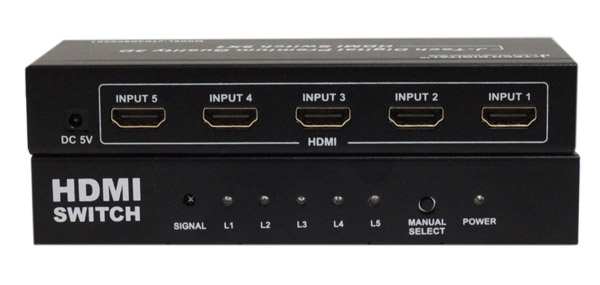Dear Big Picture Big Sound,
Hi, I was wondering if an HD signal can be split. I have an HDTV that is hooked up to my HD cablebox. The tv only has one input for the hdmi cable. My question is how can I split the signal to play my HD dvd player. I can play it with regular S-video cables but not HD cables.
PLEASE HELP
Gerard P.
Dear Gerard,
Thanks for your question. If you have two high definition devices, but only one HDMI input on your television, all is not lost! Unfortunately you can't simply split or combine two HDMI inputs into a single jack, but you do have a few options. You can either purchase a simple HDMI switch or an HDMI-switching home theater receiver, or you can use another input on your set that also supports high definition video (more on that below).
The secondary benefit of using a home theater receiver with HDMI switching is that you can also enjoy multi-channel surround sound (by using multiple speakers, of course). Some of the more recent HDMI-switching home theater receivers also support upconversion of component, composite and S-video sources to HDMI so you can connect all of your devices to the receiver - VCR, game system, camcorder, DVD player, HD set-top box, etc. - and hook up just one thin cable (HDMI) between the receiver and your HDTV.

A few recommendations for HDMI switches and HDMI switching receivers include:
Simple HDMI switches:
HDMI-Switching A/V Receivers:
But you shouldn't actually need to buy anything - it is very likely that your current set has at least one other input that supports high definition resolution. In addition to HDMI, high definition video signals can be carried over DVI connections (not too common these days on consumer HDTV models) and over component video connections (three RCA-style plugs usually colored red, green and blue at the ends and labeled "Y, Pr, Pb"). Component video connections are very common on HDTVs.
Composite video and S-Video are not capable of carrying a high definition signal, but component video is, so you can probably use component video between one of your HD devices, using HDMI for the other and still get the benefit of high definition quality on your HDTV for both sources.
As to which device to connect to HDMI and which to connect to component, this is simple: HD cable box to Component Video and HD-DVD player to HDMI. The reason for this is that HD-DVD players also upconvert standard definition DVDs to higher resolutions (720p, 1080i, 1080p), but they only do this via the HDMI outputs (not component). So if you want to get the higher resolution benefits of your HD-DVD player's upconversion circuitry, then use HDMI for that. Current HD cable boxes will output 1080i or 720p HD output over component video or HDMI so use component video for the cable box.
The one little stickler is that, in the future, it may not be possible to pass certain high definition content over component video cables. A content flag called the ICT (Image Constraint Token) could allow broadcasters and movie studios to limit or "down-res" the HD video signal to standard definition 480P resolution over component video cables. This is not something that has been activated yet, but it could be used at some point in the future. If this does come to pass while you still own your current set, then your only option would be to buy an HDMI switcher or HDMI-switching receiver.
But until then, use component video and HDMI and enjoy all that beautiful high definition content!
Regards,
-Chris
Note: Article was updated in 2015 to include current products in the suggested products links above.